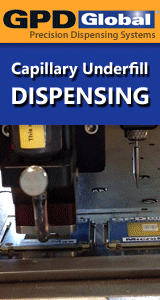Printed Circuit Board Assembly & PCB Design Forum
SMT electronics assembly manufacturing forum.
- SMTnet
- »
- Electronics Forum
- »
- Black pad on BGA after removal
Black pad on BGA after removal
![]() We have seen the black dot on the BGA pad after the componen...
- May 04, 2005
by
We have seen the black dot on the BGA pad after the componen...
- May 04, 2005
by
![]()
![]() First, you cannot determine if this is "black pad" by lookin...
- May 04, 2005
by
davef
First, you cannot determine if this is "black pad" by lookin...
- May 04, 2005
by
davef
![]()
![]()
![]() I tried soldering to several of the black pads and was succe...
- May 05, 2005
by
jimmie
I tried soldering to several of the black pads and was succe...
- May 05, 2005
by
jimmie
![]()
![]()
![]() Board fab, Defects, Pad coatings, Gold black plague articles...
- May 05, 2005
by
davef
Board fab, Defects, Pad coatings, Gold black plague articles...
- May 05, 2005
by
davef
![]()
![]()
![]() Just went through this with a customer. Removed BGAs and no...
- May 05, 2005
by
RDR
Just went through this with a customer. Removed BGAs and no...
- May 05, 2005
by
RDR
![]()
![]()
![]() Was it determined what caused the flux migration?
...
- May 05, 2005
by
jimmie
Was it determined what caused the flux migration?
...
- May 05, 2005
by
jimmie
![]()
![]()
![]() Bad cleaning practice is suspect. It is believed that W.S. ...
- May 05, 2005
by
RDR
Bad cleaning practice is suspect. It is believed that W.S. ...
- May 05, 2005
by
RDR
![]()
![]()
![]() could there have been a solderablity issue with that pad to ...
- May 05, 2005
by
jimmie
could there have been a solderablity issue with that pad to ...
- May 05, 2005
by
jimmie
![]()
![]()
![]() Not in this case, these BGAs were lead free and the profile ...
- May 05, 2005
by
RDR
Not in this case, these BGAs were lead free and the profile ...
- May 05, 2005
by
RDR
![]()
![]()
![]() Would a lesser degree of black pad still allow solderability...
- May 05, 2005
by
jimmie
Would a lesser degree of black pad still allow solderability...
- May 05, 2005
by
jimmie
![]()
![]()
![]() I don't believe that you are seeing black pad. I think you ...
- May 05, 2005
by
RDR
I don't believe that you are seeing black pad. I think you ...
- May 05, 2005
by
RDR
![]()
![]()
![]() The black pads that we see are on the BGA component. We rem...
- May 05, 2005
by
jimmie
The black pads that we see are on the BGA component. We rem...
- May 05, 2005
by
jimmie
![]()
![]()
![]() You got what I think someone has called a "cold melt". If y...
- May 05, 2005
by
RDR
You got what I think someone has called a "cold melt". If y...
- May 05, 2005
by
RDR
![]()
![]()
![]() Thanks Russ and Dave for time and patience.
Best regards
...
- May 05, 2005
by
jimmie
Thanks Russ and Dave for time and patience.
Best regards
...
- May 05, 2005
by
jimmie
![]()
Jimmie
- SMTnet
- »
- Electronics Forum
- »
- Black pad on BGA after removal







